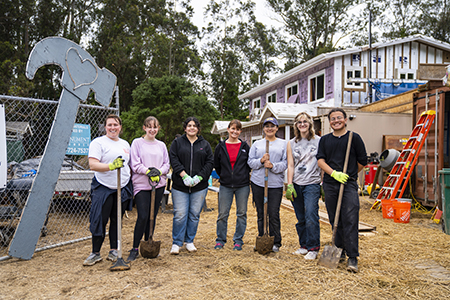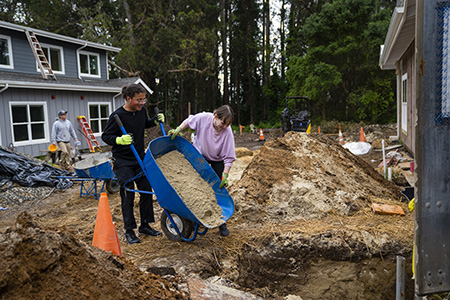This project was made possible by a grant to UC Santa Cruz from the Monterey Peninsula Foundation and the Blum Center's generous donors.
In an effort to provide relief to low-income families in Santa Cruz—a county at the center of rising housing costs—Habitat for Humanity is in the process of completing almost a dozen new homes.
At Rodeo Creek Court—Habitat’s eleven-home development in the Live Oak neighborhood of Santa Cruz—six families have already moved in. Habitat is working to complete the remaining five homes by June 2024.
On May 6, five UCSC undergraduates, one graduate student, and two faculty members working with The Blum Center on Poverty, Social Enterprise, and Participatory Governance spent their Saturday volunteering at the build site, highlighting one of the experiential learning opportunities UCSC students are gaining from a partnership with Habitat for Humanity.
These new affordable housing units—built on property donated by Santa Cruz County—will provide a safe haven for a diverse group of individuals, including teachers, a Navy veteran, two families displaced by the CZU fires, five single parents, and children.
As these families settle into their new homes, they will soon have a place to call their own—a safe haven where they can grow, thrive, and make memories that will last a lifetime. Among the duplexes they are building, there are eight three-bedroom homes and two two-bedroom homes, as well as a stand-alone ADA compliant three-bedroom home.
This is only one project of many that Habitat for Humanity has spearheaded in an effort to expand
affordable housing in Santa Cruz County. Now in partnership with UC Santa Cruz’s Blum Center, Habitat will soon be able to quantify and showcase the full impact of their work.
“Habitat for Humanity Monterey Bay knows that they're making an impact on people's lives,” said Blum Center Program Manager Lisa Nishioka. “One can imagine all of the beneficial effects gaining affordable housing might have across the lifespan of a family and on future generations.
We’re excited to understand and document those short—and long—term impacts and to be able to advocate for their program—both to donors and to elected officials—about the importance of supporting Habitat in their endeavors.”
Eleven undergraduate research interns with UCSC’s Blum Center have spent the past year interviewing Habitat homeowners and assessing the impact of affordable housing on multi-generational economic security, civic engagement, well-being, and opportunity.
The Blum Center’s project goals include documenting and assessing program impacts to further enhance capacity, educating UCSC students about affordable housing and fostering community-engaged research skills, and raising awareness in the community and among policymakers of the importance and benefits of affordable housing.
Emmy Boe (Oakes ’24, community studies), an undergraduate researcher with The Blum Center, said interviewing homeowners and gaining hands-on experience was eye-opening.
“We learn a lot at UCSC from our professors in an academic sense,” Boe said, “but being involved in community-based organizations and research, we learned so much embodied knowledge from the people who live in the community that you wouldn't get at the university.”
Nearly 60 percent of renters in Santa Cruz County spend 30 percent or more of their household income on rent. Habitat for Humanity hopes to alleviate the housing burden for low-income families through affordable home-ownership opportunities.
Lyndsey Marks, Director of Resource Development for Habitat for Humanity Monterey Bay, shared their policy and program model which ensures that Habitat homeowners never pay more than 30 percent of their combined monthly income.
“We are creating stability for people,” Marks said. “We believe that, for the community as a whole, it really benefits to have people who can build strong roots in Santa Cruz.”
Habitat building sites are spearheaded by Construction Managers Dylan Childs and Keaton Port-Gaarn, and Construction Associate Sal Dibiasi. In addition, the construction crew relies on a dedicated team of volunteers, coordinated by Volunteer and Event Manager, Allie Wilson. The volunteer crew includes Habitat homeowners, who must put in 500 hours of sweat equity in order to attain their home.
UCSC student Rosalie Lansing (Rachel Carson ’24, sociology and linguistics) volunteered at the Live Oak build site on May 6.
“Doing this project [with the Blum Center] gave me more tools to advocate for affordable housing, which is something I want to do in the future,” she said. “Getting to do the analysis of all of the data we've collected and being able to see which impacts are most prominent, makes me excited to be able to do more work with this topic and be able to advocate for affordable housing and resources.”
The Blum Center is excited to share its findings with Habitat for Humanity Monterey Bay later this summer.
“We need to be able to share why this matters for people,” Marks said. “Some of the Blum Center students shared that they had experienced housing insecurity growing up, and they could relate to some of the stories they were hearing. I am really inspired by their commitment and their passion for our work.”
This project was made possible by a grant from the Monterey Peninsula Foundation and the Blum Center's generous donors.
Interested in getting involved?





